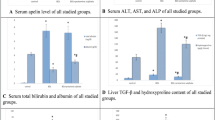Abstract
We do not know much about the changes that occur in reduced (GSH) and oxidized (GSSG) glutathione in the development of liver cirrhosis. Therefore, we investigated the glutathione redox system during development of liver cirrhosis after bile-duct ligation in rats. We compared the GSH and GSSG content of liver and plasma between bile-duct-ligated rats and sham-operated controls 6 and 24 h and 5, 15, 23, and 38 days after operation. Compared to controls (x±SD: 6.07±0.52 μmol/g wet wt.), liver GSH significantly increased 24 h (+37%) and 5 days (+53%) after bile-duct ligation. Thereafter, GSH continuously declined to 4.25±0.64 μmol/g (−31%; P<0.001) at the end of the observation period after 38 days. The GSH turnover in 5-day bile-duct-ligated rats with high GSH concentrations was not significantly different than in shamoperated controls (16 nmol/min per g after bile-duct ligation and 15 nmol/min per g in controls). GSSG (211±42 nmol/g wet wt. in controls) was significantly lower 6 and 24 h after bile-duct ligation (−34% and −43%, respectively). Thereafter, GSSG increased and was about 100% higher than in controls after 23 and 38 days. The relation of GSSG to GSH in liver continuously increased from 3.4 to 20.5% after bile-duct ligation. The course of plasma GSH (9.57±0.79 μmol/l) paralleled hepatic GSH on a lower level: +14% at day 5, −41% at day 15 and −51% at the end of the observation period. Plasma GSSG (0.99±0.31 μmol/l) was inversely related to liver GSSG: there were increased concentrations early after bile duct ligation (day 5: +91%) and reduced concentrations (−44%) at the end of the observation period. Dynamic changes of the glutathione status occur in the development of liver cirrhosis after bile-duct ligation. These changes are consistent with increased oxidative stress in the liver and a deficit of transporting GSSG from the cells into plasma.
Similar content being viewed by others
References
Adams JD, Lauterburg BH, Mitchell JR (1983) Plasma glutathione an glutathione disulfid in the rat: regulation and response to oxidative stress. J Pharmacol Exp Ther 227: 749–754
Chawla RK, Lewis FW, Kutner MH, Bate DM, Roy RGB, Rudman D (1984) Plasma cysteine, cystine, and glutathione in cirrhosis. Gastroenterology 97: 770–775
Deleve LD, Kaplowitz N (1990) Importance and regulation of hepatic glutathione. Semin Liver Dis 10: 251–266
Deneke SM, Barry LF (1989) Regulation of cellular glutathione. Am J Physiol 257: L163–L173
Griffith OW, Meister A (1979) Glutathione: interorgan translocation, turnover, and metabolism. Proc Natl Acad Sci USA 76: 5606–5610
Jewell SA, Di Monte D, Gentile A, Guglielmi A, Altomare E, Albano O (1986) Decreased hepatic glutathione content in chronic alcoholic patients. J Hepatol 3: 1–6
Kountouras J, Billing BH, Scheuer PJ (1984) Prolonged bile duct obstruction: a new experimental model for cirrhosis in the rat. Br J Exp Pathol 65: 305–311
Krähenbühl, S, Talos C, Lauterburg B, Reichen J (1995) Reduced antioxidative capacity in liver mitochondria from bile duct ligated rats. Hepatology 22: 607–612
Kretschmar M, Francke H, Zimmerman T, Dargel R, Klinger W (1989) Glutathione synthesis and export in experimental liver cirrhosis induced by thioacetamide: relation to ultrastructural changes. Exp Toxicol Pathol 35: 114–122
Ookhtens M, Lyon I, Fernandez-Checa J, Kaplowitz N (1988) Inhibition of glutathione efflux in the perfused rat liver and isolated hepatocytes by organic anions and bilirubin. J Clin Invest 82, 608–616
Ookthens M, Maddatu T, Kapplowitz N, Lyon I (1989) Mechanism of declining hepatic GSH efflux with age in the rat. Hepatology 10: 649–656
Poulson HE, Ranek L, Andreasen PB (1981) The hepatic glutathione content in liver disease. Scand J Clin Lab Invest 41: 573–576
Purucker E, Wernze H (1990) Hepatic efflux and renal extraction of plasma glutathione: marked differences between healthy subjects and the rat. Klin Wochenschr 68: 1008–1012
Purucker E, Wernze H, Tittor W (1989) No evidence for heptic efflux of glutathione into plasma: investigations in healthy controls and in patients with hepatic cirrhosis. J Hepatol 9 [Suppl 1]: S 75
Purucker E, Egri L, Hamar H, Augustin AJ, Lutz J (1991) Differences in glutathione status and lipid peroxidation of red and white muscles: alterations following ischemia and reperfusuion. Res Exp Med 191: 209–217
Purucker E, Wernze H, Krandik G (1995) Glutathione in plasma, liver, and kidney in the development of CCl4-induced cirrhosis of the rat. Res Exp Med 195: 193–199
Siegers C-P, Bossen KH, Younes M, Mahlke R, Oltmanns D (1982) Glutathione and glutathione-S-transferases in normal and diseased human liver. Pharm Res Commun 14: 61–72
Author information
Authors and Affiliations
Rights and permissions
About this article
Cite this article
Purucker, E., Winograd, R., Roeb, E. et al. Glutathione status in liver and plasma during development of biliary cirrhosis after bile duct ligation. Res. Exp. Med. 198, 167–174 (1998). https://doi.org/10.1007/s004330050100
Received:
Accepted:
Published:
Issue Date:
DOI: https://doi.org/10.1007/s004330050100




